Reviews
La Novia Ensangrentada
Vicente Aranda
Spain, 1972
Credits
Review by Victoria Large
Posted on 22 February 2011
Source Anchor Bay DVD
Categories Lesbian Vampires
Vicente Aranda’s Spanish-language thriller The Blood Spattered Bride (which is, disappointingly, most widely available on an English-dubbed DVD) opens with a screen awash in red liquid, assuring audiences that the picture will live up to its sensational, drive-in worthy title. (The title was latterly nicked by Quentin Tarantino, a fan of the film, to head up a chapter of Kill Bill, Vol. 1.) But The Blood Spattered Bride also prominently touts its literary origins, giving a full-screen credit to Sheridan Le Fanu and Carmilla just moments later. The tension between grindhouse gore and literary legitimacy carries throughout: even from within the safe confines of a living room and the crisp mastering of DVD, Aranda’s thriller whispers of hiccupy projection, sticky floors, and bargain matinees. Yet it’s also possessed of a dreamy Gothicism that haunts rather than bludgeons.
Maribel Martín is Susan, the bride of the title, first glimpsed in an outrageously long white veil that seems constantly in danger of being trampled, soiled, or torn. The imagery isn’t subtle. The virginal Susan surveys her veiled figure in a mirror, then gazes at the bed in her honeymoon suite with ambivalence before being seized up by a kind of waking nightmare: an imagined sexual assault at the hands of man who looks rather like her (tellingly) unnamed husband. And while her husband seems aware of Susan’s conflicting emotions (“You survived your wedding night,” he says, a bit ominously, the morning after.), he isn’t particularly sympathetic to them. Indeed, while The Blood Spattered Bride’s women are bound up in a whole lot of masculine anxiety about women (more on that later), Susan’s husband is an unsettling figure too. He’s a thinly sketched character who, like Susan, doesn’t seem to have any life at all outside of this honeymoon, and - even for a newlywed - he is almost cartoonishly obsessed with the bedroom. In one of his worst moments, he drags Susan by her hair in an attempt to seduce - or rather coerce - her.
It is in this anxious atmosphere that a spectral blonde woman begins to appear in Susan’s dreams, and soon enough, her waking life as well. Browsing a gallery of portraits in her husband’s ancestral castle, Susan asks why there are no pictures of women. Turns out they keep those in the cellar as a result of a harrowing family history. Mircalla Karstein, the bride of one of Susan’s husband’s distant relations, murdered her husband with a dagger on their wedding night.
The sight of Mircalla’s portrait in the cellar - a woman in a bridal gown wielding a dripping weapon, with a hole cut through the canvas where her face once was - is chilling but a bit nonsensical. Why commission a portrait just to deface it and hang it in the basement? Still, it gets the job done, and soon Susan - and the audience - are faced with the grisly possibility of history repeating.
One of the key differences between The Blood Spattered Bride and its source material emerges here. In Carmilla, the eponymous vampire seduces and threatens to destroy her female victims, but does not encourage them to commit violence themselves. In Arenda’s film, Mircalla comes to Susan in dreams and exhorts her, Lady MacBeth-like, to seize the dagger and dispose of her husband via notably non-supernatural means. In a nightmare that is at first indistinguishable from the reality of the film, Susan executes the brutal crime, splattering her marriage bed with her husband’s blood in a horrific, knowing reversal of the sexual implications of the film’s title. This scene in particular illustrates how the film straddles art and exploitation: on the one hand, it presents the imagined murder with a kind of leering, here-comes-the-money-shot stance. On the other, it puts me in mind of Buñuel’s The Discreet Charm of the Bourgeois, the surreal landmark which was released the same year and which blurs reality in much the same way. (Both films anticipate the prankish, dream-within-a-dream sequences employed by John Landis in An American Werewolf in London almost ten years later.)
When Susan’s dreamed-of Mircalla shows up for real, calling herself Carmilla, the many tensions of the film come to a head. Soon Carmilla and Susan are disappearing into the mist together, trysting and making attacks on the men of the film. And yes, the attacks subvert one of horror’s sturdiest genre norms: men stalking women. But to call Carmilla, brought to witchy, ethereal life by Alexandra Bastedo, a feminist figure (as some critics carelessly have) without at least the benefit of scare quotes, is to misunderstand feminism rather profoundly. No, the quite literally murderous and castrating Carmilla is, like many a 1940s femme fatale before her, a character who embodies anxiety rather than ideology. Taking into consideration Susan’s generic, boorish husband, The Blood Spattered Bride comes to feel like a stylish fever dream about some of men’s and women’s worst fears about one another.
The Blood Spattered Bride’s really-not-very-sub subtexts and eerie visuals - ruined palace estates; wandering veiled women; the wings of frightened, fluttering birds - make it a compelling watch for horror devotees. However, its indulgence in ham-fisted shock tactics (never more so than at its abrupt, bullet-ridden conclusion) and its ultimately murky gender politics make it a very weird watch too, the dubbed-English voices on my DVD only heightening the film’s slipperiness and unreality. It is, to be certain, an antidote to the slick, unreflective sadism of many a more recent horror flick. What else it may be is hard to define.
More Lesbian Vampires
-
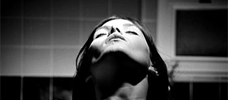
Rape of the Vampire
1968 -

The Vampire Lovers
1970 -

Lust for a Vampire
1971 -
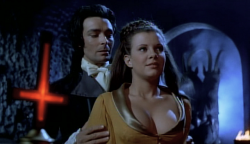
Twins of Evil
1971 -
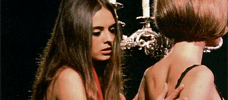
Vampyros Lesbos
1971 -
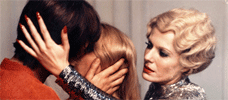
Daughters of Darkness
1971 -
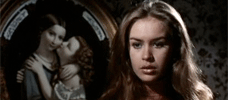
The Blood Spattered Bride
1972 -
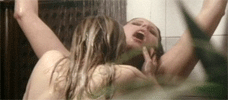
Vampyres
1974
We don’t do comments anymore, but you may contact us here or find us on Twitter or Facebook.



